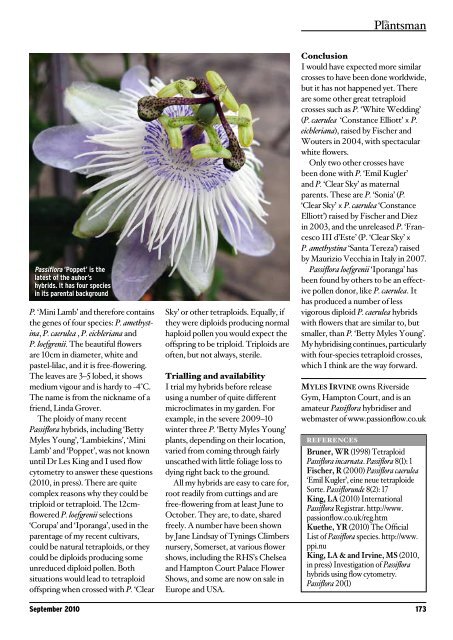Breeding hardy Passiflora - Passion Flowers
Breeding hardy Passiflora - Passion Flowers
Breeding hardy Passiflora - Passion Flowers
You also want an ePaper? Increase the reach of your titles
YUMPU automatically turns print PDFs into web optimized ePapers that Google loves.
The<br />
Plantsman<br />
<strong>Passiflora</strong> ‘Poppet’ is the<br />
latest of the auhor’s<br />
hybrids. It has four species<br />
in its parental background<br />
P. ‘Mini Lamb’ and therefore contains<br />
the genes of four species: P. amethystina,<br />
P. caerulea , P. eichleriana and<br />
P. loefgrenii. The beautiful flowers<br />
are 10cm in diameter, white and<br />
pastel-lilac, and it is free-flowering.<br />
The leaves are 3–5 lobed, it shows<br />
medium vigour and is <strong>hardy</strong> to -4°C.<br />
The name is from the nickname of a<br />
friend, Linda Grover.<br />
The ploidy of many recent<br />
<strong>Passiflora</strong> hybrids, including ‘Betty<br />
Myles Young’, ‘Lambiekins’, ‘Mini<br />
Lamb’ and ‘Poppet’, was not known<br />
until Dr Les King and I used flow<br />
cytometry to answer these questions<br />
(2010, in press). There are quite<br />
complex reasons why they could be<br />
triploid or tetraploid. The 12cmflowered<br />
P. loefgrenii selections<br />
‘Corupa’ and ‘Iporanga’, used in the<br />
parentage of my recent cultivars,<br />
could be natural tetraploids, or they<br />
could be diploids producing some<br />
unreduced diploid pollen. Both<br />
situations would lead to tetraploid<br />
offspring when crossed with P. ‘Clear<br />
September 2010<br />
Sky’ or other tetraploids. Equally, if<br />
they were diploids producing normal<br />
haploid pollen you would expect the<br />
offspring to be triploid. Triploids are<br />
often, but not always, sterile.<br />
Trialling and availability<br />
I trial my hybrids before release<br />
using a number of quite different<br />
microclimates in my garden. For<br />
example, in the severe 2009–10<br />
winter three P. ‘Betty Myles Young’<br />
plants, depending on their location,<br />
varied from coming through fairly<br />
unscathed with little foliage loss to<br />
dying right back to the ground.<br />
All my hybrids are easy to care for,<br />
root readily from cuttings and are<br />
free-flowering from at least June to<br />
October. They are, to date, shared<br />
freely. A number have been shown<br />
by Jane Lindsay of Tynings Climbers<br />
nursery, Somerset, at various flower<br />
shows, including the RHS’s Chelsea<br />
and Hampton Court Palace Flower<br />
Shows, and some are now on sale in<br />
Europe and USA.<br />
Conclusion<br />
I would have expected more similar<br />
crosses to have been done worldwide,<br />
but it has not happened yet. There<br />
are some other great tetraploid<br />
crosses such as P. ‘White Wedding’<br />
(P. caerulea ‘Constance Elliott’ x P.<br />
eichleriana), raised by Fischer and<br />
Wouters in 2004, with spectacular<br />
white flowers.<br />
Only two other crosses have<br />
been done with P. ‘Emil Kugler’<br />
and P. ‘Clear Sky’ as maternal<br />
parents. These are P. ‘Sonia’ (P.<br />
‘Clear Sky’ x P. caerulea ‘Constance<br />
Elliott’) raised by Fischer and Diez<br />
in 2003, and the unreleased P. ‘Francesco<br />
III d’Este’ (P. ‘Clear Sky’ x<br />
P. amethystina ‘Santa Tereza’) raised<br />
by Maurizio Vecchia in Italy in 2007.<br />
<strong>Passiflora</strong> loefgrenii ‘Iporanga’ has<br />
been found by others to be an effective<br />
pollen donor, like P. caerulea. It<br />
has produced a number of less<br />
vigorous diploid P. caerulea hybrids<br />
with flowers that are similar to, but<br />
smaller, than P. ‘Betty Myles Young’.<br />
My hybridising continues, particularly<br />
with four-species tetraploid crosses,<br />
which I think are the way forward.<br />
Myles Irvine owns Riverside<br />
Gym, Hampton Court, and is an<br />
amateur <strong>Passiflora</strong> hybridiser and<br />
webmaster of www.passionflow.co.uk<br />
references<br />
Bruner, WR (1998) Tetraploid<br />
<strong>Passiflora</strong> incarnata. <strong>Passiflora</strong> 8(1): 1<br />
Fischer, R (2000) <strong>Passiflora</strong> caerulea<br />
‘Emil Kugler’, eine neue tetraploide<br />
Sorte. Passiflorunde 8(2): 17<br />
King, LA (2010) International<br />
<strong>Passiflora</strong> Registrar. http://www.<br />
passionflow.co.uk/reg.htm<br />
Kuethe, YR (2010) The Official<br />
List of <strong>Passiflora</strong> species. http://www.<br />
ppi.nu<br />
King, LA & and Irvine, MS (2010,<br />
in press) Investigation of <strong>Passiflora</strong><br />
hybrids using flow cytometry.<br />
<strong>Passiflora</strong> 20(1)<br />
173
















